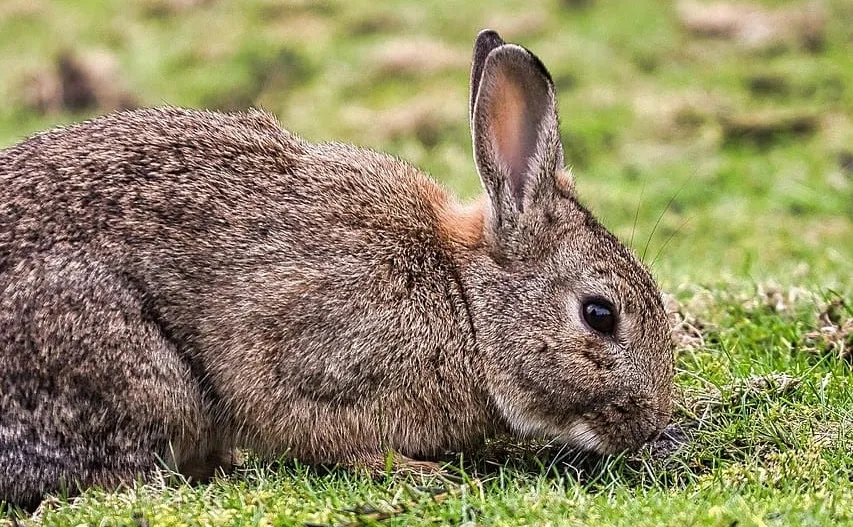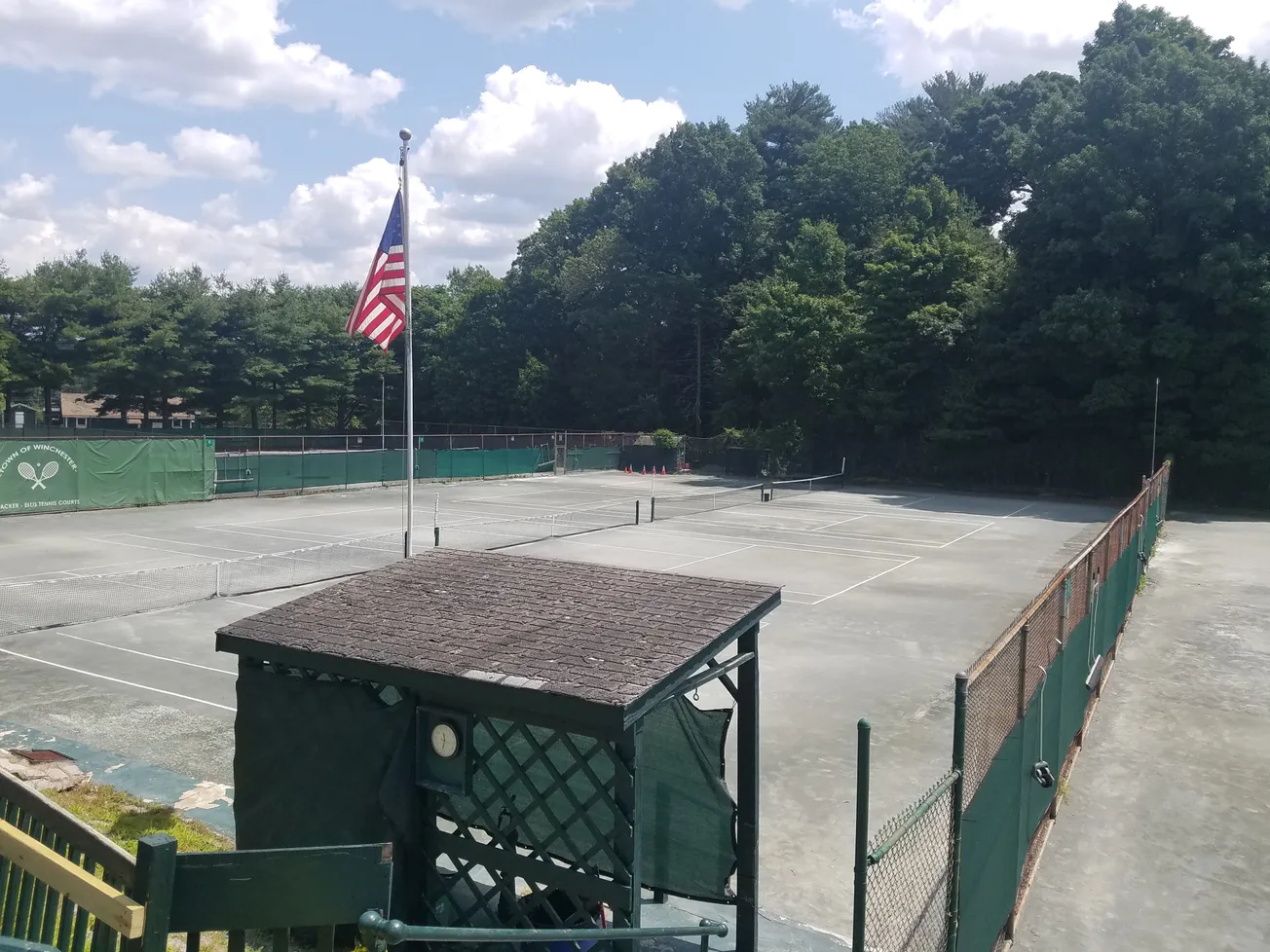Table of Contents
By Reed Pugh
July 17, 2023. Everyone is having challenges with rabbits in their gardens, and it has gotten worse in recent years. The following is an immersive dive into rabbits and strategies to manage their browsing on plants in your garden.
First, there are, for the most part, two different species of rabbit that live in our New England gardens: New England Cottontail (native) and the Eastern Cottontail (brought in from Mid-west). As with everything nowadays, invasives are causing a challenge in the garden. Here is a link to a Mass Audubon article on rabbits.
The native cottontail tends to be larger with shorter ears, that are rimmed with a black edge. They will have a dark or black spot on their forehead and have a darker coat with some black fur. The introduced Eastern Cottontail will be smaller with a lighter brown/cinnamon coat with longer ears and a white blaze or spot on the forehead. The New England Cottontail tends to be found in forests and woodland areas, while the Eastern evolved on more open, mid-western plains, which explains why the Eastern has significantly larger eyes than the native rabbit.
Rabbits tend to live in larger colonies, with the females taking sole responsibility for raising the young. In season, they tend to stay in a relatively small area and don't roam over distance, which explains why happy rabbits in your garden will continue to breed and expand the colony. Rabbits tend not to live more than two years, and the majority don't make it to their first birthday. A colony can have several males and a larger number of females. As a fun fact, a group of wild rabbits is called a Fluffle. Adorable, despite their aggravating activities in our gardens.
If you find clumps of cottony material around the gardens, chances are you have a nest of bunnies somewhere. Moms will collect grass, twigs and combine with their belly fur to cover up the nest, and will spend daylight hours resting away from the nest so as not to attract predators. When rabbit colonies are comfortable in their space and have plenty of food, they may give birth to three or more litters of 3-5 bunnies each year. With up to 15 bunnies per female each year, even with many bunnies not making it to adulthood, you can see how quickly populations can explode.
Populations ebb and flow, but we are definitely in a growth period. I believe a major reason for recent increases is a result of a decrease in predators, though I did just see a Red Tail Hawk grab a rabbit right in front of me last week. Another theory that I have read, is that homeowners during the Pandemic spent more time in their gardens and planted more food and flowers. This basically increased the amount and quality of food for rabbits, thereby making them more comfortable and having more litters.
Finally, rabbits do not hibernate, and need food year round, so you can never stop protecting your gardens. Understanding when they are active and what they eat, will help you manage them effectively. During the winter, you will find them chewing on woody material, with the lack of grass and fresh green materials. They are getting food, water and nutrients from chewing on younger stems of plants by either cutting them down or chewing the outer layers to get to the living layer. Physically protecting susceptible plants and spraying stems will minimize damage. Roses, fruit trees, young trees, Clethra, Fothergilla, arborescens Hydrangeas are just a few that they like. Often, they become active before we get out in the garden. Late Winter they will start heavy feeding and often gardeners get caught out before they have a chance to protect. I was spraying susceptible plants in January.
In the season, waves of damage happen as young litters of bunnies start feeding indiscriminately, so it is important to protect through the early growing season as many new and growing bunnies hit the garden. By mid-summer, the pressure on plants decreases as the populations decrease from their peak and the younger bunnies are no longer the fast growing, voracious eaters in their youth.
With gardening, we often find ourselves reacting to developments, whether it is disease, insects, pruning, weeding, rabbits, etc. I spend a lot of time helping people anticipate and direct activity in the garden. With rabbits, if you react, then you can lose flowers, crops and valued plants. Anticipate warmer weather in the Winter and early Spring and employ your strategies before they cause damage. Know what plants they go after and protect them before they attack.
It used to be that we knew the plants that rabbits would eat and we could manage them, but the population explosion has led to an expanded palette of plants that rabbits eat, including many that we thought were rabbit-proof. In the Spring with young bunnies, they will often try everything as they don't know better, so extra vigilance is required from April-July. Taste is an important part of a rabbit's decision to eat a specific plant, but smell is the overriding sense. Strongly flavored plants, and those with oils (think Mediterranean) are mostly avoided, but not as much in recent years. This year I have seen them eat Marigolds and Lavender, which makes me want to pull my hair out!
Rabbits and Deer will often sample new plants, and I encourage that you deploy your strategy the same day that you add any new plants, whether they are rabbit proof or not. This will help to instruct animals that these are not on the menu. The worst thing for a new, young plant is to be mowed to the ground before it can get established.
Following is a list of strategies to minimize unwanted damage from rabbits in your garden, while allowing them to coexist. Often times multiple strategies are required in each season and may be different from winter to summer.
· A physical barrier is the only guarantee of protection. It needs to be dug 6" into the ground or staked well into the ground and typically 3' minimum height. In winter, protection needs to take into account potential snow height, as damage can often be 3-4'+ high. Food crops absolutely need to be fenced, whether loose or raised beds. Make sure it is metal, as they chew right through plastic.
· Liquid sprays can be highly effective, but if you miss an application, or we have heavy rain, like this Spring, it can be hard to keep it on plants with high efficacy. I prefer and use Liquid Fence. Buy a spray bottle or pump and mix your own from concentrate to save some money. Hold your nose. Nature's Mace, Bobbex, Plantskyyd are other decent products, but I don't use them. Follow directions as more isn't always better and you can burn plants.
· Many of the above brands have granules that can be placed around beds and plants. In important beds, I will use spray and granules. Liquid Fence has a granular application, but these will dissipate quickly with heavy rains.
· Natural and homemade concoctions can be effective, but rarely have the staying power of commercial products that will stay on plants longer. Many people believe in hot pepper (cayenne) sprays and granules. Pepper can be put in water with a drop of dish soap as a surfactant, and sprayed on plants. People will soak dried hot peppers in a jug of water in the sun for a week and apply.
· Human hair is a remedy for many things, but it needs to be free of fragrant hair products that will attract animals, so despite the unappealing idea of going to the local hair salon to crowdsource your town's hair, chances are that it will be covered in shampoo and conditioner from freshly washed hair. Feel free to add any hair you pull out from your own head.
· Fox/Coyote urine is commonly discussed, but I have not heard good efficacy or longevity, but if you have bad browsing, including Deer, then deploying multiple strategies, including urine, can be more effective.
· Blood meal or Dried Blood basically tells animals that something is dead, and can be a good deterrent, however, it is pure nitrogen and needs to be applied carefully around smaller plants as it will burn and create vegetative growth rather than flowers. Placing this along fence lines and over-trafficked areas can be a good deterrent or stop entry to a garden.
· Irish Spring and Coast Soap shavings can be used as a supplement around important plants. Good thing about these shavings is that they don't disappear overnight, however using too much will make your garden smell. Irish Spring, Liquid Fence and fish emulsion combined will keep anyone out of the garden.
· Fish Emulsion is a great supplemental strategy but not highly effective by itself. Neptune's Harvest is a great foliar fertilizer that I recommend during the summer several times. It smells like the ocean at low tide. Buy an applicator that you add to the end of your hose to spray across your entire garden.
· Solar-powered, motion-activated, ultrasonic repellers can be an excellent supporting strategy in key garden areas. Not a great solution if you have pets that spend time in the area.
· There is a lot of discussion, with varied results, about creating separate gardens for animals. I've heard people plant separate veggie gardens for rabbits and groundhogs. I am considering planting a natural wildflower garden in a lawn area to keep them out of a perennial border. If you have some space, this is probably one of the least intrusive ideas to allow humans and rabbits to live together. Give them their own buffet.
· Rabbits love grass, and clover is like dessert for them. Consider allowing clover to grow in your lawn or seed in clover in the fall. It is a great sustainable addition to your lawn, keeping it green and more drought tolerant. However, this only works in season.
Create a strategy for your garden that covers the whole year. In the Summer, rabbits tend not to chew on woody material because there is so much tasty, fresh green material. When fresh plants are not available you need to focus on plants that will provide their off-season nutrition, and this may require temporary physical protection around young trees and woody plants that they like.
Create times on your digital calendar to remind yourself throughout the year to deploy your strategy before the rabbits go to work. Get your cages up before it is too late in the fall and start spraying as there are forecasts for warm periods throughout the Winter and early Spring.
This sounds complicated and a lot of work, but really isn't once you find what works in your garden. Depending upon the size of your garden, it may only take a short time to spray on a regular schedule. The real problem is remembering to get out and do the work. Utilizing 3 or 4 of the above ideas can really keep the damage to a minimum. Rabbits don't eat a lot of plants, so you just need to focus in areas they like to browse.
One absolute thing we cannot do is poison rabbits. This will only make the problem worse as predators will eat the poisoned rabbits and die themselves.
Reed Pugh is a Winchester horticulturist and educator who helps people get the most out of their gardens @ Barking Dog Gardens








